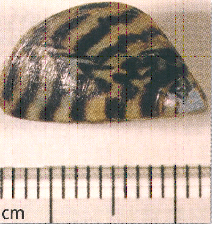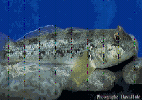


The zebra mussel is a small mollusc living in fresh water. It has inhabited the waters of the river Richelieu since 1994. It is native of Europe and was introduced in an accidental way, in North America around the year 1986 in the region of the Great Lakes.
We suppose that its presence in North America might result from the draining of waters of a ship of European origin. The shell of the zebra mussel is brown with white stripes. It has an average life span of three years and measures up to 3 centimetres.
The zebra mussel is classified as an intrusive species; it proliferates very quickly because it has a big capacity of adaptation to all types of aquatic habitats. We know that the female can lay up to a million eggs a year. In the river Richelieu, for example, surveys have found up to 40 000 of them per square meter.
It is a species which engenders numerous problems on its ecosystem. Indeed, the zebra mussel considerably reduces the quantity of phytoplankton and so decreases the quantity of food indispensable to the other native species.

The round goby was discovered for the first time in the waters of the river Sainte-Clair, at the end of the 1980s. It is native of Europe and is presumed to have been accidentally introduced in North America by a ship from the Eastern Europe.
Today we find it almost everywhere in Quebec in particular on the banks of the river Richelieu. The round goby is a small fish which possesses small black spots on the back. It can live up to five years and can measure up to 25 centimetres in length.
This species is singular because it possesses ventral fins which form a suction cup, which allows it to hang on to the bed of the river when the currents are powerful. We find it in diverse depths and it prefers sea bed established by sands or by small loose stones.
It is an intrusive species because it can reproduce several times a year. It mainly eats small fishes, insects living in the heart of the waters, small aquatic organisms and also fish eggs.
This species provoke negative impacts on its ecosystem and more particularly on the other species of fish because it eats their eggs and also the youngest.
The Tench is a fish which was discovered for the first time in 1994 by a fisherman in Haut-Richelieu. This species is native of Europe and Asia and was introduced in Quebec by a private breeder. Individuals are supposed to have escaped from this breeding and to have reached the river Richelieu in the 1990s.
The tench lives in fresh and quiet water, it has a lengthened shape and the colour of the skin varies between green and yellow. It mainly eats insects’ larvae, water plants and small molluscs.
The tench is intrusive species because it reproduces very quickly. Thus, the female can lay up to 800 000 eggs a year!
Today we have enough hindsight to understand and know the impacts which its proliferation will have on the aquatic ecosystem. Nevertheless, we know that a too important population of tenches will engender the destruction of certain native species.